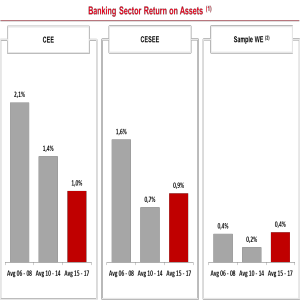
CEE Banking Study 2016: A more sustainable growth model is moving forward (UniCredit press release):
- Most CEE economies showed strong economic growth in 2015 and proved more resilient towards shifts in investors´ sentiment with regards to emerging markets
- Overall banking sector profitability is normalizing on a new post-crisis level, still double the one of Western Europe
- Growing reliance on local deposits and strong capital adequacy ratios partially diminish past vulnerabilities
In 2015 the economic environment for banks operating in Central and Eastern Europe (CEE) has been rather positive. Despite some exceptions, most countries in the region showed strong economic growth and resilience against shifts in investors´ sentiment towards emerging markets, which was in good part related to their deep integration with the euro area and the solid macroeconomic fundamentals. Banking sectors in most countries have remained profitable, although the overall level is normalizing compared to the pre-crisis period.
These are some of the key findings of the latest CEE Banking Study, which was conducted by UniCredit´s CEE Strategic Analysis department and which covers 13 different countries. Looking forward, economic recovery is expected to further support lending, especially in countries which have been lagging behind so far. Non-performing loans ratios, which are currently high in various countries should decline.
Most CEE economies have shown 2015 a more dynamic performance than in previous years
"Although country-by-country differentiation persists as a regional key feature, there were some positive developments in the banking sectors in CEE. Lending has improved in some countries and the banking sectors remained mostly profitable. A more sustainable funding model is moving forward in CEE, with local deposits becoming a more important funding source", said Carlo Vivaldi, Head of CEE Division at UniCredit, "Nevertheless banks need to be attentive towards the low interest environment, regulatory pressures, the development of emerging markets, geopolitical tensions and the effects from migration."
With GDP growth rates ranging from 0.6 percent in Serbia to 4.3 percent in the Czech Republic in 2015, most CEE countries have shown a more dynamic performance compared to previous years. The only exceptions are Russia, which had to cope with a sharp drop in the oil price and the EU-US sanctions, and Ukraine, which faced and the loss of major production capacities in the Eastern part of the country.
Moreover the new EU-members in Central Europe (EU-CEE1]) have proved more resilient to the shift in investors' sentiment towards emerging markets in the second half 2015. In doing so, EU-CEE benefitted from current account surpluses or small deficits due to strong exports into the euro area, low commodity prices and large capital account surpluses due to EU fund inflows. Additional support came from accommodative monetary policy and more robust domestic demand.
Loans-to-deposits ratio significantly improved, bank lending to accelerate
"Bank lending has improved in some countries, in particular in Central Europe", stated Mauro Giorgio Marrano, Deputy Head of CEE Strategic Analysis at UniCredit, "The growth dynamics in other countries have been weaker and in some cases also affected by one-off factors. With regards to household loans local currency is gaining weight compared to FX lending meaning past vulnerabilities keep on diminishing."
[1]
Most of the local banking sectors have maintained profitability over the past years, the average loans-to-deposits ratio improved significantly from 122 percent 2008 to 101 percent 2015.
Looking forward, UniCredit researchers expect the economic recovery to support lending, especially in countries which so far have been lagging behind.
Moreover positive GDP growth in combination with accommodative monetary policies and clean-up activities in countries such as Romania, Slovenia and Hungary should ease the strain from NPLs. Profitability is expected to remain above Western European levels.
CEE region remains the growth engine for UniCredit
In spite of some challenges, UniCredit considers itself a long-term, strategic investor in Central and Eastern Europe, which is keen to develop its business with both corporate and private customers in the region. In 2015 the banking group has acquired over 1.2 million new customers across all CEE countries, where it has a presence, and it intends to grow its customer base by another 1 million customers each year until 2018.
According to its Strategic Plan UniCredit is going to invest EUR 1.2 billion into digitalization aiming equally at matching new trends in customer behaviour and reducing cost. The number of internet banking users is projected to increase from currently 5 million to 10 million and the number of mobile banking users from currently 1 million to 7 million over the next three years. CEE lending volume is expected to grow by EUR 20 billion to EUR 106 billion in 2018.
UniCredit is still the banking group number one in Central and Eastern Europe - in terms of network, total assets and geographic diversification.
The banking group operates an extensive network of almost 3,100 branches in 13 countries, which generates roughly one quarter of its total revenues. UniCredit in CEE serves more than 25,000 international corporate customers through its International Centers. 2 out of 3 international corporate customers from Germany, Italy and Austria operating in CEE are UniCredit customers. The banking group has a long-established expertise in handling state and EU-supported programs in the CEE region resulting in more than EUR 2 billion facilities dedicated to EU Funds projects approved and another over EUR 1.3 billion agreements signed. UniCredit banks are among the top-banks in their respective home country.
"Its broad diversification by customers, products and geographies has made CEE region a consistently strong contributor to the Group´s financial results. With the intended transfer of CEE shareholdings directly under UniCredit SpA by year-end 2016 we make another move towards a leaner governance structure as well as a more effective capital and liquidity management", said Carlo Vivaldi, Head of CEE Division at UniCredit, "We are fully committed to the new Strategic Plan and go ahead with investing into digitalization and Big Data in order to expand our regional customer business."

